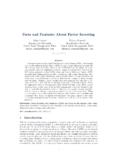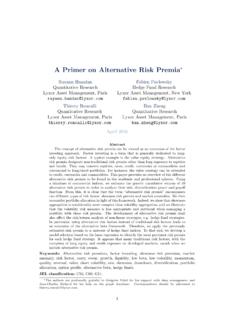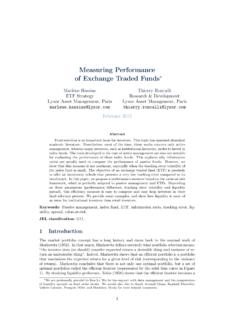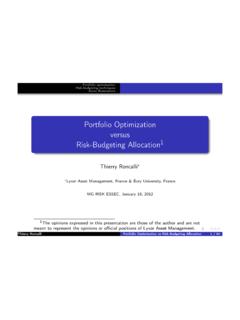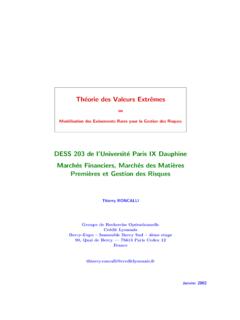Transcription of UnderstandingtheImpactofWeights …
1 Understanding the Impact of WeightsConstraints in Portfolio Theory Thierry RoncalliResearch & DevelopmentLyxor Asset Management, 2010 AbstractIn this article, we analyze the impact of weights constraints in portfolio theory usingthe seminal work of Jagannathan and Ma (2003). They show that solving the globalminimum variance portfolio problem with some constraints on weights is equivalentto use a shrinkage estimate of the covariance matrix. These results may be easilyextended to mean variance and tangency portfolios. From a financial point of view, theshrinkage estimate of the covariance matrix may be interpreted as an implied covariancematrix of the portfolio manager. Using the universe of the DJ Eurostoxx 50, we studythe impact of weights constraints on the global minimum variance portfolio and thetangency portfolio. We illustrate how imposing lower and upper bounds on weightsmodify some properties of the empirical covariance matrix. Finally, we draw someconclusions in the light of recent developments in the asset management :Global minimum variance portfolio, Markowitz optimization, tangency portfo-lio, Lagrange coefficients, shrinkage methods, covariance classification:G11, IntroductionWe consider a universe ofnassets.
2 We denote by the vector of their expected returnsand by the corresponding covariance matrix. Let us specify the Markowitz problem inthe following way:min12w> {1>w= 1w C(1)wherewis the vector of weights in the portfolio and is the search space. For example,if =Rn, the optimisation problem defines the global minimum variance portfolio. if I am grateful to Ghislain Yanou (University of Paris-1, UG5/CES/CNRS) who has participated to aninternal seminar in Lyxor Asset Management and has introduced me to the work of Jagannathan and Ma(2003).1 Understanding the Impact of Weights Constraints in Portfolio Theory ={w Rn: >w ?}, we obtain the efficient portfolio where ?is the desired expectedreturn of the investor. The tangency portfolio is the efficient portfolio which maximizes theSharpe the set of weights constraints. We consider two definitions equal toRn. In this case, the solution is unconstrained and we note itw?orw?( , ). may impose some boundsw i wi w+ion the weight of the asseti.}
3 In thiscase, we noteC=C(w , w+)and we define was the solution of the correspondingoptimisation idea of this paper is to analyse the impact of constraintsC(w , w+)on the discrep-ancy betweenw?and w. Following Jagannathan and Ma (2003), we may show that theconstrained solution may be obtained by solving the unconstrained problem with anotherspecification of and . We have also: w=w?( , )where and are perturbations of the original vector of expected returns and the originalcovariance matrix . Traditionally, the impacts of weights constraints are analysed bystudying the difference betweenw?and w. In this paper, we analyse these impacts bystudying the difference between the implied parameters and and the original parameters and .The paper is organized as follows. In section two, we review the main results of Jagan-nathan and Ma (2003) and we illustrate these results with an example. In section three,we consider an empirical application on the DJ Eurostoxx 50 universe.
4 We focus on theglobal minimum variance portfolio and the tangency portfolio, because Demeyet al.(2010)has shown that restrictive constraints on weights should be imposed for these methods inorder to avoid extreme concentration in optimized portfolios. We illustrate how these con-straints impact the covariance matrix, in terms of volatilities, correlations and risk , section 4 draws some conclusions in the light of recent developments in the assetmanagement The effects of constraints in portfolio theoryIn this section, we review the main results of Jagannathan and Ma (2003) for three portfoliooptimisation problems (global minimum variance portfolio, mean variance portfolio andtangency portfolio). We illustrate each problem with the same generic example of 4 assetsand the covariance matrix given in 1:Specification of the covariance matrix (in %) i i, the Impact of Weights Constraints in Portfolio The global minimum variance Analytics of the solutionThe global minimum variance portfolio corresponds to the solution of the optimisation prob-lem (1) when =RnandC=Rn.
5 We define the Lagrange function as:f(w; 0) =12w> w 0(1>w 1)with 0 0. The first order conditions are:{ w 01= 01>w 1 = 0We deduce that the optimal solution is:w?=11> 1 11 This solution depends only on the covariance matrix and we notew?=w?( ).If we impose now the weights constraintsC(w , w+), the Lagrange function becomes:f(w; 0, , +)=12w> w 0(1>w 1) >(w w ) +>(w+ w)with 0 0, i 0and +i 0. In this case, the Kuhn-Tucker conditions are: w 01 + += 01>w 1 = 0min( i, wi w i)= 0min( +i, w+i wi)= 0It is not possible to obtain an analytic solution but we may numerically solve the optimisationproblem using a quadratic programming An implied covariance matrixGiven a constrained portfolio w, it is possible to find a covariance matrix such that wis the solution of the global minimum variance portfolio. LetE={ >0 : w=w?( )}denotes the corresponding set. We have:E={ >0 :(1> 1) w=1}Of course, the setEcontains several solutions. From a financial point of view, we areinterested to covariance matrices which are closed to.}
6 Jagannathan and Ma (2003)remark that the matrix defined by: = +( + )1>+1( + )>(2)3 Understanding the Impact of Weights Constraints in Portfolio Theoryis a solution ofE. It is easy to show that is a positive definite matrix and we have: w= w+( + )1> w+1( + )> w= w+( + )+1( + )> w= 01+1( 01 w)> w=(2 0 w> w)1 Because wis a constant vector, it proves that wis the solution of the unconstrainedoptimisation implied covariance matrix defined by the equation (2) is very interesting for twopoints: This implied covariance matrix is easy to compute when we has solved the constrainedoptimisation problem, because it only requires the computation of the Lagrange coef-ficients. This implied covariance matrix has a natural interpretation. Indeed, we have: i,j= i,j+ i,jwhere the elements of the perturbation matrix are:( )i,jw i]w i, w+i[w+iw j ( i+ j) j +i j]w j, w+j[ i0 +iw+j +j i +j +i+ +jThe perturbation i,jmay be negative, nul or positive.
7 It is nul when the optimizedweights do not reach the constraints wi6=(w i, w+i)and wj6=(w j, w+j). It is positive(resp. negative) when one asset reaches its upper (resp. lower) bound whereas thesecond asset does not reach its lower (resp. upper) bound. Introducing weights con-straints is also equivalent to apply a shrinkage method to the covariance matrix (Ledoitand Wolf, 2003). Lower bounds have a negative impact on the volatility whereas upperbounds have a positive impact on the volatility: i= 2i+ i,iThe impact on the correlation coefficient is more complex. In the general case, wehave: i,j= i,j i j+ i,j ( 2i+ i,i)( 2j+ j,j)The correlation may increase or decrease depending on the magnitude of the Lagrangecoefficients with respect to the parameters i,j, iand lagrange coefficient ?0for the unconstrained problem is2 0 w> wwhere 0is the Lagrangecoefficient for the constrained the Impact of Weights Constraints in Portfolio An illustrative exampleLet us consider the universe of 4 assets with the covariance matrix specified in these parameters, the global minimum variance portfolio is equal to:w?
8 = In this portfolio, we have two long positions on the first and second assets and two shortpositions on the third and four assets. Suppose now that we impose a no short-sellingconstraint. All the results (in %) are reported in Table2. In the constrained optimizedportfolio, the weights of the third and fourth assets are set to zero. Imposing the constraintswi 0implies also to decrease the volatility of these two assets. Indeed, the impliedvolatility iof the third asset is equal its volatility iis equal to25%.Concerning the correlations, we notice that they are lower than the original ones, but thedifference is 2:Global minimum variance portfolio whenwi 0 wi i +i i i, Table3and4, we report the results when the lower bound is respectively10%and20%. It is interesting to notice that the ranking of volatilities is not preserved. Finally,we illustrate in Table4the case when both lower and upper bounds are imposed.
9 In theprevious results, we observe a decrease of volatilities and correlations. In Table4, the effectis more complex and correlations may increase and 3:Global minimum variance portfolio whenwi 10% wi i +i i i, 4:Global minimum variance portfolio whenwi 20% wi i +i i i, the Impact of Weights Constraints in Portfolio TheoryTable 5:Global minimum variance portfolio when0% wi 50% wi i +i i i, The mean variance portfolioLet us now consider the problem when we impose to reach an expected return: >w= ?Without constraints on bounds, the Lagrange function is:f(w; 0, 1) =12w> w 0(1>w 1) 1( >w ?)with 0 0and 1 0. The first order conditions are: w 01 1 = 01>w 1 = 0 >w ?= 0 With constraints on bounds, the Lagrange function becomes:f(w; 0, , +)=12w> w 0(1>w 1) 1( >w ?) >(w w ) +>(w+ w)with 0 0, 1 0, i 0and +i 0.
10 In this case, the Kuhn-Tucker conditions become: w 01 1 + += 01>w 1 = 0min( i, wi w i)= 0min( +i, w+i wi)= 0We may show that the constrained portfolio wis the solution of the unbounded optimizationproblem: w=w?( , )with the following implied expected returns and covariance matrix2:{ = = + ( + )1>+1( + )>2 Indeed, we have: w= w+` + 1> w+1` + > w= 01+ 1 +1( 01 w)> w= 2 0 w> w+ ? 1 1+ 1 It proves that wis the solution of the unbounded optimization problem with Lagrange coefficients ?0=2 0 w> w+ ? 1and ?1= the Impact of Weights Constraints in Portfolio TheoryWe consider the previous example and we assume that expected returns are respectively5%,3%,7%and7%. In this case, the optimal portfolio for ?= 6%isw?1= ,w?2= ,w?3= If we impose that the weights arebetween0%and40%, we obtain results in Table6. We remark that the correlation betweenthe first and second assets increases by30%whereas the other implied correlations arevery close to the original correlations.}
